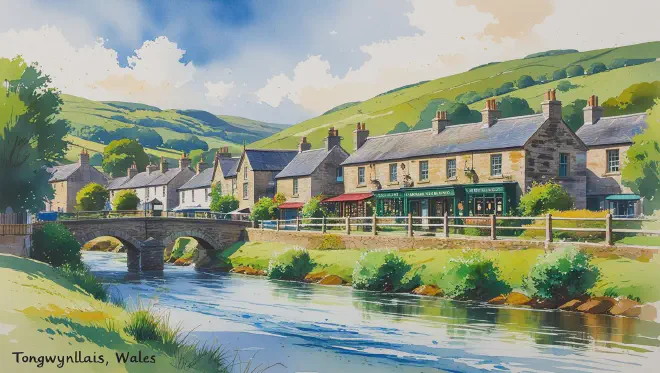Introduction
Tongwynlais is a small village nestled just ten kilometers north of Cardiff, the capital of Wales. Situated along the River Taff, this quiet settlement carries the echoes of the Industrial Revolution when iron works brought prosperity to the valley, yet it remains embraced by lush, rolling countryside that seems untouched by time. The village name derives from Welsh words meaning “white meadow,” and true to its etymology, the landscape unfolds like a living painting—white sheep dotting gentle hillsides, stone cottages with slate roofs, and ancient dry-stone walls threading through emerald fields.
The crown jewel of Tongwynlais is undoubtedly Castell Coch, the “Red Castle” that rises from the wooded hills like something from a fairy tale. Its distinctive red conical roofs and cream-colored walls might appear fantastical, but the castle stands as a remarkable 19th-century reconstruction of medieval ruins, embodying both Gothic revival artistry and authentic historical foundations. The village maintains a living Welsh culture—many residents speak Cymraeg (Welsh) in their daily lives, and Celtic traditions continue to flourish alongside the remnants of industrial heritage.
This is a place where past and present exist in gentle harmony, where the whispers of ancient forests mingle with stories etched in stone. As I prepared to begin my journey to this corner of Wales, I felt drawn not just to its scenic beauty, but to the deeper currents of history, culture, and community that flow beneath its tranquil surface.

Day 1: The Red Castle and Stones That Remember
The train from Cardiff Central Station carried me northward along the Taff Valley, a twenty-minute journey that felt like traveling backward through time. As urban sprawl gave way to green hills and scattered farms, I could sense the rhythm of life slowing with each mile. Alighting at Taff’s Well station, I was immediately struck by the quality of silence—no traffic hum, just birdsong and the whisper of wind through grass.
The thirty-minute walk to Tongwynlais followed the River Taff, its waters running clear and gentle between banks lined with willows and wild roses. To my left, the river caught and scattered morning light like scattered coins; to my right, sheep-dotted hills rolled away toward distant forests. This was Wales as I had always imagined it—pastoral, peaceful, touched with an almost mystical quality that made each step feel like a pilgrimage.
The red turrets of Castell Coch appeared through the trees long before I reached the village proper. First, though, I needed to check into my accommodation: Tŷ Gwyn (White House), a stone-built bed and breakfast dating from the 1800s. Gwyn, the proprietor, welcomed me with a mixture of English and Welsh that immediately conveyed the bilingual nature of the community. “Croeso i Gymru,” she said warmly—Welcome to Wales—and in those simple words, I heard centuries of cultural pride and resilience.
After settling in, I set off through the afternoon light toward Castell Coch. The path wound upward through dense woodland, my footsteps muffled by layers of fallen leaves that carpeted the forest floor. Ancient oaks and beech trees formed a living cathedral overhead, their branches filtering sunlight into golden shafts that illuminated the occasional red squirrel darting between trunks. The air smelled of moss, earth, and the green scent of growing things.
When the castle finally came into full view, I stopped in genuine wonder. Its fairy-tale appearance—those distinctive red conical towers, the cream walls rising from a foundation of local stone—struck me as both whimsical and imposing. But as I drew closer, the medieval substance beneath Victorian romanticism became apparent. This was no mere folly, but a serious recreation of fortress architecture, built with genuine respect for the defensive structures that once commanded this hilltop.
Inside, the rooms unfolded like chambers from a dream. The circular library particularly captivated me: books rose floor to ceiling in perfectly fitted shelves, while afternoon light streamed through stained glass to paint the reading desk in jeweled colors. Standing in that room, surrounded by centuries of accumulated knowledge and craftsmanship, I felt connected to something larger than myself—the unbroken chain of human creativity and aspiration.
Evening brought me back to the village and to The Lewis Arms, an 18th-century pub that clearly served as the community’s living room. Local men gathered at the bar, their conversation flowing between Welsh and English with easy familiarity. I settled in with a bowl of cawl, the traditional Welsh soup of lamb and vegetables that has warmed travelers for generations. Served with crusty bread and butter, it was simple food made sublime by perfect execution and the warmth of genuine hospitality.
As darkness fell, I returned to Tŷ Gwyn and stood at my bedroom window, cup of Welsh tea in hand, gazing up at a canopy of stars invisible in any city. The day’s experiences settled in my mind like sediment in still water: the castle’s medieval grandeur filtered through Victorian imagination, the pub’s easy camaraderie, the forest’s ancient peace. Already, I could feel this place weaving itself into my memory.
Day 2: Forest Paths and Industrial Echoes
Morning began with Gwyn’s full Welsh breakfast—a feast that told the story of Wales on a single plate. Laverbread, made from local seaweed, brought the taste of nearby coasts; cockles from the Gower Peninsula provided briny sweetness; local bacon and sausages spoke of traditional farming practices unchanged for generations. The laverbread, dark and intensely flavored, was an acquired taste, but Gwyn explained its importance: “Fishermen and miners have eaten this for centuries—it kept them strong.”
After breakfast, I set out to explore the Taff Trail, a walking and cycling path that follows the route of the old Glamorganshire Canal and railway lines once used to transport coal and iron from the valleys to Cardiff docks. The trail offered an ideal way to understand how this peaceful landscape had once hummed with industrial activity. Stone bridges and canal locks punctuated the riverside path, their weathered surfaces bearing witness to an era when Wales powered much of the world’s industry.
Along the way, I encountered David, a retired miner taking his daily constitutional. We fell into conversation, and he painted vivid pictures of the valley’s industrial heyday. “The river ran black then,” he said with a rueful smile, “and the air was thick with smoke. But it was work, and good work too.” Looking at the clear water flowing past us, I reflected on the landscape’s remarkable recovery and the complex legacy of Wales’s industrial past.
The afternoon found me at Fforest Fawr Country Park, where the remains of old ironworks have been thoughtfully preserved within regenerating woodland. Massive stone foundations and rusted machinery create striking counterpoints to the wildflowers and birdsong that now claim this space. I spent hours exploring the site, fascinated by how nature and industry could be reconciled rather than simply separated.
The park’s visitor center provided deeper context, with exhibits covering both the area’s natural history and its industrial heritage. I was particularly drawn to displays showing Welsh-language names for local flora and fauna: “Draig Goch” (red dragon) for ladybird, “Blodyn yr Haul” (flower of the sun) for sunflower. These poetic designations revealed a culture that sees nature through eyes of wonder and affection, even as it grappled with the demands of heavy industry.
Walking back through the village as evening approached, I discovered St. Michael’s Church, a simple stone building dating from the 12th century. Inside, afternoon light filtered through modest stained glass to illuminate wooden pews worn smooth by centuries of worship. The atmosphere was one of quiet continuity—faith practiced in the same space for nearly a thousand years, connecting generation to generation in an unbroken chain of community life.
Dinner at The Lewis Arms featured faggots and mash—traditional pork meatballs with creamy potatoes and rich gravy. The regular customers now acknowledged me with friendly nods, and I began to understand how quickly small communities can embrace respectful visitors. These casual interactions, more than any guidebook, revealed the genuine character of Welsh hospitality.
Back at the B&B, Gwyn had lit a fire in the lounge, and I spent the evening watching flames dance in the hearth while processing the day’s experiences. The juxtaposition of industrial heritage and natural beauty, the survival of Welsh language and culture, the warmth of community life—all these elements seemed to converge in this small village where past and present coexist with remarkable grace.
Day 3: Morning Mists and Lasting Impressions
My final morning in Tongwynlais began before dawn, with a solitary return to Castell Coch. Mist clung to the valley, transforming the familiar landscape into something ethereal and mysterious. The castle emerged from the fog like a vision from ancient legends, its red towers seeming to float above the white blanket that shrouded the forest floor.
I walked slowly around the castle grounds, savoring the profound quiet broken only by birdsong and the distant sound of water flowing over stones. In this early light, without other visitors, the building revealed different aspects of its character—more austere, perhaps, but also more authentic. The stones spoke not just of Victorian romanticism but of genuine medieval purpose: defense, community, the human need for both security and beauty.
After a final breakfast with Gwyn—who pressed a bag of homemade Welsh cakes into my hands “for the journey”—I climbed to the village’s highest point for a farewell view. From this vantage, the entire valley spread below: the River Taff winding between hills, Castell Coch rising from its wooded prominence, the village houses scattered like children’s blocks among green fields. Cardiff’s distant skyline provided subtle reminder of the wider world, but here in this moment, Tongwynlais felt complete unto itself.
My last stop was Siop Fach (Little Shop), the village’s tiny store selling Welsh books, local crafts, and postcards of the castle. The proprietor, Marian, recommended a volume of Welsh poetry, and though I couldn’t read the language, the sound of her reading aloud revealed music in the words themselves—rhythm and cadence that seemed to echo the landscape’s own natural poetry.
The walk back to Taff’s Well station retraced my arrival route, but everything looked different now. The river, the hills, the distant castle—all had become familiar friends rather than mere scenery. As the Cardiff train approached, I felt the particular melancholy that comes with leaving a place that has briefly become home.
From the carriage window, I watched Tongwynlais recede into the Welsh countryside, but the images remained vivid in my mind: morning mist on the castle towers, the warmth of The Lewis Arms, conversations with David and Gwyn, the play of light through forest canopy. These memories, gathered over just three days, felt as solid and lasting as the medieval stones of Castell Coch itself.
Conclusion
This journey to Tongwynlais exists only in imagination, yet it feels as real and meaningful as any physical travel I have undertaken. Through the vehicle of creative description, I have walked the forest paths, tasted the traditional foods, conversed with local people, and experienced the particular magic that arises when landscape, history, and living culture converge in a single place.
The power of imaginary travel lies not in escapism but in deeper engagement—with places we hope to visit, cultures we wish to understand, and experiences that expand our sense of human possibility. In creating this fictional journey to a real Welsh village, I have discovered not just facts about geography and history, but something more precious: a sense of connection to a place and people I have never physically encountered but now feel I genuinely know.
Perhaps this is what all travel, real or imagined, ultimately offers: the opportunity to expand our capacity for empathy, wonder, and appreciation of the diverse ways humans have learned to live in harmony with their environments. The red castle of Tongwynlais, the flowing waters of the River Taff, the warmth of Welsh hospitality—these remain alive in imagination, ready to inspire future adventures both real and imagined.

